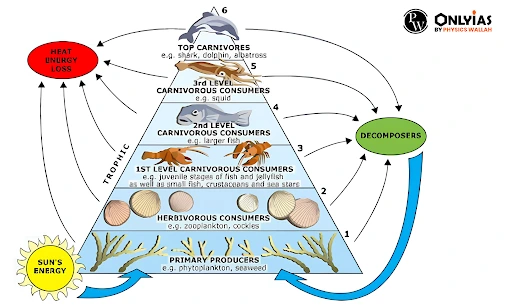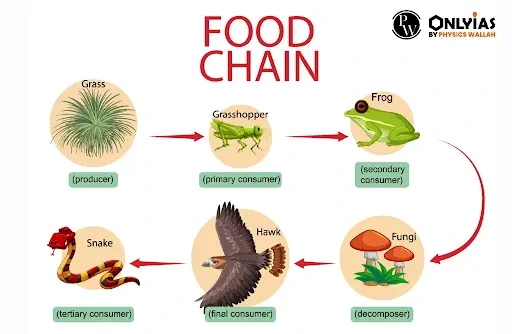|
Energy Flow in Ecosystem: Food Chain, Hierarchy, Significance & Characteristics |
Energy Flow in Ecosystem: Unlocking the Secrets
Every organism, ranging from single-celled algae to massive blue whales, requires sustenance for survival. Thus, each food chain represents a potential route through which nutrients and Energy Flow in Ecosystem.
What is the Food Chain: How Energy Flow in Ecosystems Passes from One to Another?
Definition: Food chain can be defined as the series of transfers of matter and energy in the form of food from organism to organism, vividly illustrating the essential concept of energy flow in ecosystems.
- Primary Source: Within a food chain, plants play a crucial role as they convert solar energy into food through photosynthesis. Thus act as primary food source.
Energy Flow in Ecosystem: Hierarchy, Exploring through trophic levels in Food Chains
In a typical food chain, there are several trophic levels, each occupied by different organisms.
- Producers (First Trophic Level): These are autotrophic organisms, typically plants, that capture energy from the sun through photosynthesis and convert it into organic compounds.
- They are the primary source of energy in the food chain.
- Primary Consumers (Second Trophic Level): These are herbivores that consume producers.
- They are animals that feed exclusively or primarily on plants.
- Examples include rabbits, deer, and grasshoppers.
- Secondary Consumers (Third Trophic Level): These are carnivores or omnivores that eat primary consumers.
- They obtain energy by consuming herbivores.
- Examples include foxes, snakes, and birds of prey.
- Tertiary Consumers (Fourth Trophic Level): These are typically top predators in the ecosystem that feed on secondary consumers.
-
- They are carnivores that may not have many natural predators themselves.
- Examples include wolves, hawks, and large cats.
- Quaternary Consumers (Fifth Trophic Level): In some ecosystems, there may be another level of consumers that feed on tertiary consumers.
- However, this level is less common and not always present.
Energy Flow in Ecosystem: The 10 Percent Law in Food Chains
- In a food chain, the energy flow in ecosystem adheres to the “10 percent law”.
- This law suggests that only 10 percent of energy is transferred from one trophic level to the other; rest is lost into the atmosphere.
- Since heat energy is dissipated at each trophic level, food chains typically do not extend beyond four or five trophic levels.
| Types of Food Chains | |
| Grazing food chain. | Detritus food chain. |
Energy Flow in Ecosystem: The Circle of Grazing – Exploring Land and Water Food Chains
- Energy Flow in Ecosystem through Grazing food chains start with green plants and the primary consumer is herbivores.
- On Land: Grasses → Grasshopper → Frog → Snake → Eagle.
- In Water: Phytoplankton → zooplankton → fish → seal → great white shark.
Energy Flow in Ecosystem: The Circle of Detritus – Land and Water Food Chains
- Energy Flow in Ecosystem starts from dead organic matter of decaying plants and animal bodies consumed by the microorganisms and then to detritus feeding organisms such as detritivores or decomposers and to other predators.
- On Land: On Litter → Earthworms → Snake → Eagle.
- In Water: Mangroves leaves→ Detritus→ Microorganisms→ Crab→ Small fishes→ Large fishes.
- Dead organic matter → Worms → Frog → Snake → Hawk.
Grazing Food Chain vs. Detritus Food Chain: Diverse Paths of Energy Flow in Ecosystems
| Grazing Food Chain | Detritus Food Chain |
|
|
|
|
|
|
Resolving Energy Flow in Ecosystem: The Intricacies of Food Chains
- Energy Transfer: Each step in the food chain represents a transfer of energy from one trophic level to the next, with energy being lost as heat at each step.
- Interconnections: The food chain helps illustrate how energy flows through an ecosystem and how different species are interconnected through their dietary relationships.
- Overlapping: Most ecosystems have complex food webs, where multiple interconnected food chains overlap and interact, creating a more realistic representation of energy and nutrient flow.
Significance of Food Chain in Energy Flow in Ecosystem
- Feeding Relationship: It helps in understanding the feeding relationship and the interaction between organism and ecosystem.
- Circulation in Ecosystem: It also helps to understand the mechanism of energy flow in ecosystem
- Magnification: It also helps in understanding the movement of toxic substances and the problem associated with biological magnification in the ecosystem.
Energy Flow in Ecosystem: Conclusion
- Food chains provide a simplified, yet crucial, understanding of how energy and nutrients are transferred from one organism to another.
- They offer a glimpse into the diverse diets and roles that species assume in the intricate web of life.
|
Previous Year Question (Prelims) Q. What would happen if phytoplankton of an ocean is completely destroyed for some reason? (2012)
Select the correct answer using the codes given below:
Answer (A) Q. With reference to food chains in ecosystems, consider the following statements: (2013)
Which of the statements given above is/are correct?
Answer (A) Q. Consider the following kinds of organisms: (2021)
Which of the above are primary producers in the food chains of oceans?
Answer (B) Q. Which of the following are detritivores? (2021)
Select the correct answer using the code given below
Answer (C) |

 GS Foundation
GS Foundation Optional Course
Optional Course Combo Courses
Combo Courses Degree Program
Degree Program













